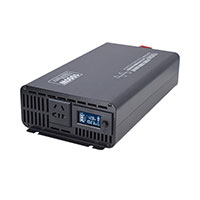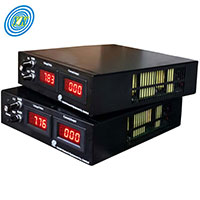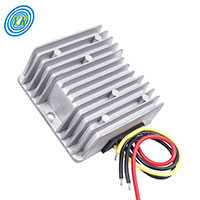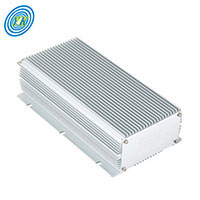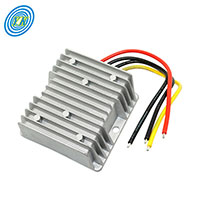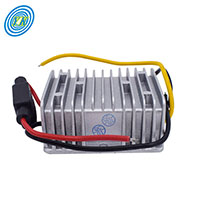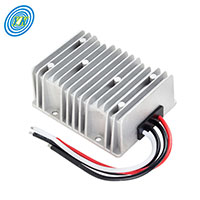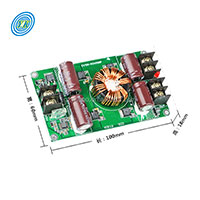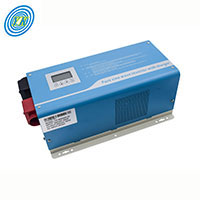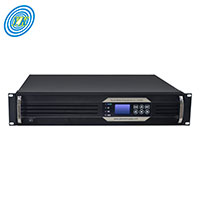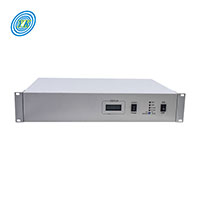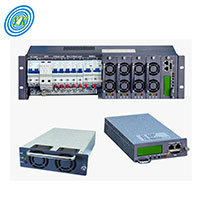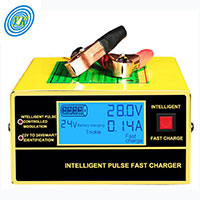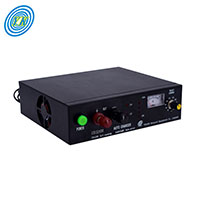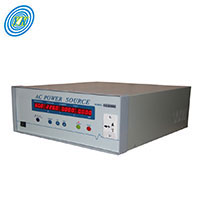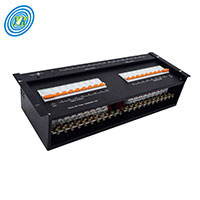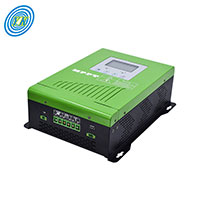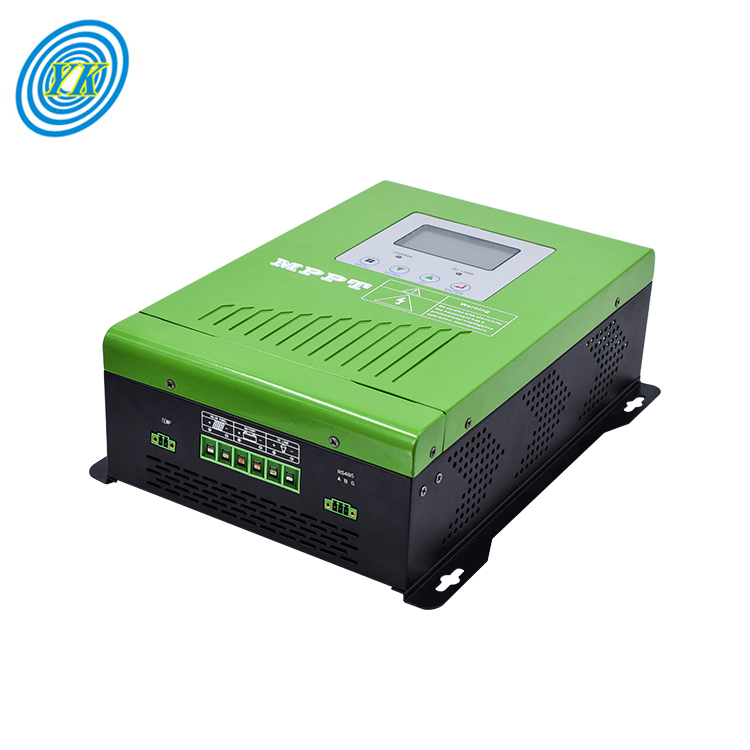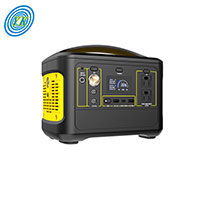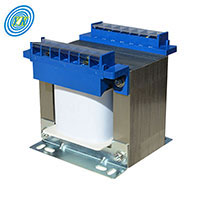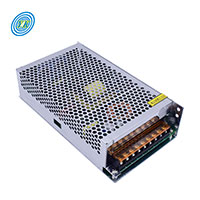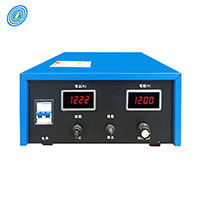
Advancements and Comparative Analyses in AC to DC Power Conversion Technologies
Click: 668 Date: 01/08/2024 2::05::18 PM
Advancements and Comparative Analyses in AC to DC Power Conversion TechnologiesSwitching Regulators: Enhancing Efficiency in AC to DC ConversionSwitching regulators, as opposed to linear regulators, are a cornerstone of modern AC to DC power conversion, offering substantial efficiency gains. Switching regulators operate by rapidly turning the power flow on and off, controlling the energy provided to the output through the duty cycle of a pulse width modulated (PWM) signal. This method drastically reduces the power loss inherent in linear regulators, where excess voltage is dissipated as heat.The efficiency of switching regulators typically ranges from 85% to 95%, compared to the 60% to 70% efficiency of linear regulators. Switching regulators achieve this high efficiency over a broad range of input voltages and load conditions, making them ideal for applications where battery life is critical or thermal management is a concern.Despite their efficiency, switching regulators introduce their own challenges, such as the generation of noise due to the high-frequency switching action. This noise, spanning a spectrum from tens of kilohertz to several megahertz, can interfere with sensitive electronic components if not adequately filtered. Therefore, the design of switching regulators often includes measures to suppress electromagnetic interference (EMI), such as using shielded inductors and proper PCB layout techniques.Switching regulators come in different topologies, including buck (step-down), boost (step-up), and buck-boost configurations, allowing them to adapt to various conversion needs. For example, a buck converter reduces voltage from a higher level to a lower level, making it suitable for applications like USB power delivery, where 5V must be regulated down from a potentially higher input voltage.In addition to their variable topologies, modern switching regulators may incorporate synchronous rectification, which replaces diodes with low-resistance MOSFETs to further enhance efficiency. This is especially useful in low-voltage applications where the voltage drop across the diode would constitute a significant efficiency loss.Designers often use a combination of switching and linear regulators to optimize performance. For instance, a switching regulator may be employed to step down a high input voltage to an intermediate level, followed by a linear regulator that provides the final voltage regulation with low noise characteristics.In conclusion, switching regulators represent a highly efficient solution for AC to DC conversion in modern electronics. Their ability to minimize power loss and handle various input conditions makes them a versatile choice for power supply design. However, their complexity and the need to manage switching noise require careful consideration during the design process.Design Principles of Full-Wave Rectification for AC to DC Power SuppliesThe design principles of full-wave rectification for AC to DC power supplies involve the conversion of both half-cycles of the input AC signal into a DC output. A full-wave rectifier typically uses either a center-tapped transformer with two diodes or a four-diode bridge without a center tap. The main goal is to maximize efficiency by utilizing the entire AC waveform, which is a significant advantage over half-wave rectification that uses only one half of the AC cycle.The full-wave bridge rectifier connects the transformer secondary winding to a diode bridge that effectively routes both halves of the AC signal to produce a unidirectional flow through the load. During the positive half-cycle of the AC input, two diodes become forward-biased and allow current to pass, while during the negative half-cycle, the other two diodes conduct, maintaining the direction of current through the load. This results in a higher output voltage and better transformer utilization compared to half-wave rectification.The peak inverse voltage (PIV) of a full-wave bridge rectifier is an important parameter, representing the maximum voltage that the non-conducting diodes must withstand. In an ideal scenario with perfect diodes, the PIV equals the maximum voltage of the transformer's secondary winding.To smooth out the pulsating DC output and reduce ripple, a capacitor or inductor filter may be added to the circuit. The capacitor charges up when the output voltage peaks and discharges through the load when the voltage falls, providing a more constant DC level. The ripple factor, which is the ratio of the AC component to the DC component in the output, is significantly lower in a full-wave rectifier compared to a half-wave rectifier.In summary, the design principles of full-wave rectification for AC to DC power supplies focus on:Efficiently converting the entire AC waveform to DC.Utilizing a center-tapped transformer or a diode bridge configuration.Managing the PIV across diodes.Smoothing the output using filtering components to reduce ripple.Ensuring the rectifier can handle the desired load and power requirements.These principles ensure that the full-wave rectifier operates effectively, providing a more consistent DC output suitable for various power supply applications.The Impact of Capacitor Filters on the Ripple Reduction in DC OutputCapacitor filters play a significant role in reducing ripple in the DC output of power conversion systems. They do so by smoothing out the fluctuations in voltage that occur after AC to DC conversion. The presence of AC components within the converted DC voltage, known as ripple, can have detrimental effects on electronic circuits, potentially causing noise, heat, and reduced efficiency.The effectiveness of a capacitor in ripple reduction is linked to its capacitance value; a larger capacitance results in a smaller ripple voltage. This is because the capacitor charges during the peaks of the AC waveform and discharges during the troughs, acting as a reservoir of electrical charge and thus leveling out the voltage variations.In high-frequency applications, such as in switch-mode power supplies, the ripple frequency is higher, and the design may incorporate additional filtering elements like inductors to form a low-pass filter which further attenuates the ripple. Moreover, the placement of the capacitor, as close as possible to the point of load, helps in minimizing the ripple observed at the load.It's also important to note that while increasing the capacitance can reduce ripple, it can also introduce other issues such as increased size of the power supply and longer charging times, which could affect the transient response. Therefore, designers often balance the capacitance value with these other considerations to achieve an optimal design that minimizes ripple while maintaining desired performance characteristics.Synchronous Rectification: A Method to Improve Power Conversion EfficiencySynchronous rectification is a power conversion technique that replaces traditional diodes with low-resistance Metal-Oxide-Semiconductor Field-Effect Transistors (MOSFETs) to improve efficiency by reducing power losses. This method is synchronized with the power supply's switching frequency, ensuring that the MOSFETs conduct during the appropriate intervals, minimizing energy loss that would otherwise occur due to the forward voltage drop inherent in diodes.The primary benefits of synchronous rectification include:Enhanced Efficiency: The low on-state resistance of MOSFETs in synchronous rectifiers reduces conduction losses, leading to more efficient power conversion compared to diode-based rectifiers.Lower Heat Production: With decreased power losses, synchronous rectifiers generate less heat, which is beneficial for thermal management and increases the reliability of the electronic system.Compact Design: The use of MOSFETs in synchronous rectifiers allows for a reduced component size, enabling further miniaturization of power supplies and electronic devices.Versatility: These rectifiers are effective over a wide range of input voltages and output currents, making them suitable for diverse applications, from telecommunications and computing to automotive and consumer electronics.Designing synchronous rectifiers involves considerations like control methods, managing dead time to prevent cross-conduction, minimizing parasitic inductance effects, and selecting the right MOSFET for optimal performance.The challenges faced in synchronous rectification include the complexity of control circuits and potential switching losses, particularly at higher frequencies. To overcome these and further enhance the performance of synchronous rectifiers, advancements are being made, such as using wide-bandgap semiconductors like gallium nitride (GaN) and silicon carbide (SiC) for their lower resistance and faster switching capabilities, and integrated synchronous rectifier solutions that combine control circuitry with MOSFETs into a single package.Linear vs. Switch Mode Power Supply: A Comparative Analysis of AC to DC ConversionIn the comparison between linear and switch mode power supplies, the key distinction lies in their method of converting AC voltage to DC voltage. Linear power supplies use a transformer to reduce the input voltage to a desired level, followed by filtration to remove any residual AC currents. This process typically results in low output ripple and noise, beneficial for sensitive applications like audio equipment or precision measurement tools. However, linear power supplies are less efficient, as they dissipate excess energy as heat, leading to larger and heavier designs.Switch mode power supplies, on the other hand, employ high-frequency switching techniques to convert the input voltage. They rapidly switch the input voltage on and off, controlling the energy provided to the transformer and subsequently to the load. This method is much more efficient, resulting in less energy wasted as heat and allowing for smaller, lighter power supplies. However, the high-frequency switching can introduce more electrical noise (ripple) into the output, which may be problematic for certain applications.The choice between linear and switch mode power supplies ultimately depends on the specific requirements of the application. Linear power supplies may be favored in low-noise, high-precision environments, whereas switch mode power supplies are typically chosen for their efficiency, compact size, and ability to handle a broader range of input voltages. When selecting a power supply, considerations such as the ambient temperature rating, power output needs, and compliance with regulatory standards like Class 2 for power output and Devicenet for networked power and data integration should be taken into account.In conclusion, while switch mode power supplies are generally preferred for their efficiency and compact size, linear power supplies are still relevant for applications demanding minimal noise and high precision. Advances in technology continue to refine both types of power supplies, making them more efficient and adaptable to a variety of uses.
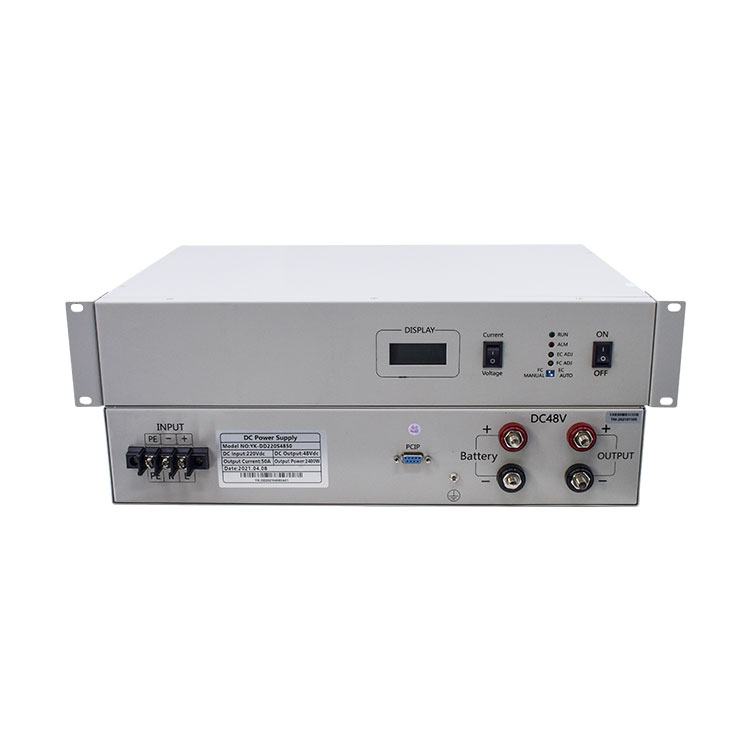
Emerging Technologies and Strategies in DC Power Supply Systems
Click: 581 Date: 01/06/2024 3::58::49 PM
Emerging Technologies and Strategies in DC Power Supply SystemsSilicon carbide (SiC) is a semiconductor material that has gained significant attention in the field of power electronics. It is known for its high mechanical, chemical, and thermal stability due to its strong silicon-carbon bond. SiC's wide bandgap property allows it to operate at higher temperatures, potentially exceeding 200°C, which is significantly higher than what silicon can withstand. This characteristic is particularly beneficial for high-voltage power applications.The ability of SiC to handle high voltages is remarkable, with the potential to tolerate voltages up to ten times that of silicon-based devices. This is due to its electric field dielectric breakdown intensity being significantly higher than silicon's. As a result, SiC devices can reach breakdown voltages ranging from 600V to several thousand volts. Moreover, the material's ability to be doped with higher concentrations allows for thinner drift layers, which reduces resistance and is advantageous for high-voltage applications.In terms of switching performance, SiC outshines traditional silicon-based IGBTs and bipolar transistors, especially at high frequencies. SiC devices, such as Schottky barrier diodes and MOSFETs, achieve high voltages with low turn-on resistance and fast operation, reducing switching losses and mitigating heat generation issues.For doping purposes, silicon carbide in its intrinsic form behaves as an insulator. However, by introducing specific impurities, it can be transformed into a semiconductor. Dopants such as aluminum, boron, or gallium create P-type semiconductors, while nitrogen and phosphorus lead to N-type semiconductors. This controlled doping process enables SiC to conduct electricity under certain conditions and surpass the limitations of silicon.Another advantage of SiC is its superior thermal conductivity, which is almost ten times that of silicon. This property enhances the material's ability to dissipate heat, allowing for higher operating voltages and temperatures without compromising the device's performance.Furthermore, the internal body diode of SiC MOSFETs exhibits a significantly faster reverse recovery time compared to their silicon counterparts. This rapid switching capability is crucial for reducing energy losses during operation.Given these benefits, SiC-based power devices are reshaping the landscape of power electronics, offering higher performance and reliability in applications such as converters, inverters, power supplies, battery chargers, and motor control systems. As the demand for energy-efficient and high-performing electronic devices continues to rise, SiC semiconductors are poised to play a pivotal role in meeting these needs.Integration of Renewable Energy Systems with DC Power"Integration of Renewable Energy Systems with DC Power" explores the fusion of renewable energy sources such as wind and solar with DC power systems to form a cohesive, stable, and efficient electrical grid. This integration is increasingly essential as renewable energy constitutes a growing percentage of the electricity produced in the United States, surpassing 20% annually.Renewable energy technologies like hydropower and geothermal utilize synchronous generators to produce electricity, while wind and solar power often rely on power electronics-based inverters to convert DC to grid-compatible AC power. For example, wind energy harnesses the kinetic energy of wind through turbines connected to generators, which may include inverters for AC power conversion. Similarly, solar energy comes in two main forms: photovoltaic (PV), which directly converts sunlight into DC electricity, and concentrating solar power (CSP), which uses heat from the sun to drive steam turbines connected to generators.The variability of renewable sources, dependent on environmental conditions, presents technical challenges for grid integration. To ensure grid stability and reliability, solutions such as geographic diversification of resources, improved power-sharing across regions, flexible demand response, and enhanced forecasting are being developed. Additionally, energy storage technologies like lithium-ion batteries and pumped hydro, along with demand response strategies, provide energy balancing across various time scales. Inverter-based resources also offer advanced functionalities to respond to transient and dynamic grid conditions.These efforts are part of a broader initiative to modernize the grid, enabling high levels of renewable integration. Advanced distribution management systems and real-time grid operation tools are critical to this transformation. The National Renewable Energy Laboratory (NREL) continues to develop technologies and tools to facilitate this integration, ensuring that the power systems of the future can accommodate a significant influx of renewable energy.Impact of Electromagnetic Compatibility on Power QualityThe influence of Electromagnetic Compatibility (EMC) on Power Quality (PQ) is a critical aspect of electrical engineering that ensures the reliable operation of electronic systems and the integrity of power networks. Electromagnetic compatibility refers to the ability of electrical equipment to function correctly in its electromagnetic environment without introducing intolerable electromagnetic disturbances to other equipment in that environment. Power quality, on the other hand, pertains to the stability and purity of the electrical power supplied to systems.When electronic devices and systems are not electromagnetically compatible, they can generate electromagnetic interference (EMI), which can degrade the quality of power. Such disturbances can result in a wide array of issues, including data loss, system malfunctions, and equipment damage. In severe cases, electromagnetic disturbances can lead to catastrophic failures in critical infrastructure, such as healthcare equipment, industrial control systems, and telecommunications networks.To mitigate the risks associated with EMI, engineers design equipment and systems with EMC considerations in mind. This involves the use of shielding, filtering, and grounding techniques, as well as adherence to strict regulatory standards that limit the amount of electromagnetic emissions that devices can produce. Additionally, sensitive equipment may be designed with stricter immunity requirements, ensuring they can resist higher levels of electromagnetic noise without malfunctioning.In summary, EMC is essential for maintaining power quality and the overall reliability of electrical and electronic systems. Without proper EMC practices, the increasing complexity and interconnectivity of modern technology would lead to more frequent and severe disruptions, highlighting the importance of EMC in the contemporary electrical engineering landscape.The Role of Battery Storage in Electric TransportationBattery storage plays a crucial role in electric transportation, acting as the heart of electric vehicles (EVs), providing the necessary power for propulsion, electronics, and auxiliary systems. Lithium-ion batteries, the most common type used in EVs, offer several advantages over traditional lead-acid batteries, such as higher energy density, longer lifespan, and faster charging capabilities.One of the key functions of battery storage is extending the driving range of electric vehicles. High-capacity lithium-ion batteries significantly increase the driving range of electric vehicles, allowing them to travel further on a single charge, thus alleviating range anxiety concerns.Another important role of battery storage is in efficient energy conversion. It enables the conversion of stored electrical energy into mechanical energy, powering the electric motor. This results in improved fuel efficiency, reduced energy losses, and enhanced overall performance.Many electric vehicles also incorporate regenerative braking technology, which allows the battery to recharge itself while the vehicle decelerates or comes to a stop. This feature not only increases energy efficiency but also helps extend the battery's lifespan.Battery storage technology is also revolutionizing the way we move. Its pivotal role in powering electric vehicles, coupled with ongoing innovations, has the potential to transform the transportation sector and contribute to a sustainable future.In conclusion, battery storage technology is playing a pivotal role in propelling electric transportation into the future. With the rise of electric vehicles, battery advancements have become essential in addressing range limitations, reducing charging time, and enabling the integration of renewable energy. The rapid transition to electric transportation offers numerous benefits such as reduced emissions, lower operating costs, and improved air quality. As battery storage and electric transportation continue to evolve, the future holds immense potential for a sustainable and cleaner transportation system.
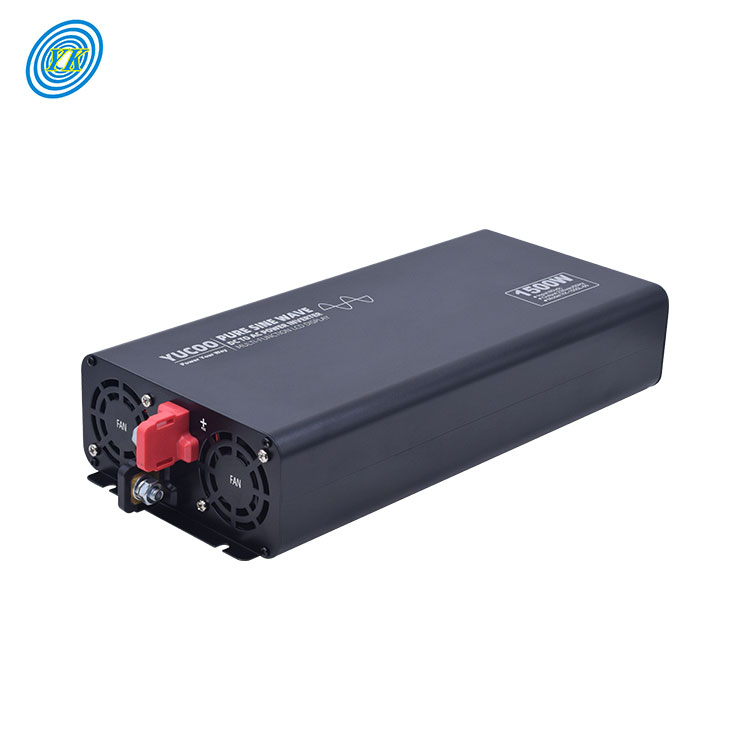
Comprehensive Guide to Power Inverters: Types, Functions, and Applications
Click: 572 Date: 01/05/2024 10::08::03 AM
Comprehensive Guide to Power Inverters: Types, Functions, and Applications"Understanding the Basics of Power Inverters" involves comprehending what they are, how they work, and their applications in various contexts.A power inverter is a device that converts Direct Current (DC) to Alternating Current (AC). This is crucial because while many vehicles and batteries produce DC, most household appliances require AC to operate. This makes power inverters essential for running household devices off a car battery or renewable energy sources like solar panels.Power inverters function by applying a voltage difference across a wire, causing the free electrons in the wire to move in the same direction. This movement of electrons is referred to as current. When a wire is connected to the positive and negative terminals of a battery, a circuit is completed, and electrons begin to flow.DC electricity flows in one direction, from one terminal directly to another. It can be compared to a river, with the current of water flowing in a single direction. On the other hand, AC electricity alternates, with the electrons flowing forwards and backwards constantly. This constant change in direction is why it's called "alternating" current. AC can be compared to the tide of the sea, which constantly flows in and out.The process of converting DC to AC involves creating this alternating flow of electrons. This is usually achieved by having a magnet rotating past coils of wire in the inverter. The magnetic field of the rotating magnet pushes and pulls the electrons in the wire, causing them to move back and forth, thus creating AC electricity.Power inverters are commonly used in cars, RVs, and boats to power appliances and devices that normally run on AC power. They are also used in "off-grid" living situations, where larger power inverters are connected to banks of batteries and solar grids to power basic appliances.When choosing a power inverter, it's important to match the inverter to the voltage of the power source (usually a 12-volt battery) and ensure that the inverter's wattage rating exceeds the total wattage of all the devices you plan to run simultaneously. It's also important to consider any peak or surge wattage requirements of your devices."Exploring the Varieties of Power Inverters: A Journey from Half-Bridge to Full-Bridge"In the realm of power electronics, inverters play a critical role in converting direct current (DC) into alternating current (AC). Among the diverse types of power inverters, the Half-Bridge and Full-Bridge inverters are two significant categories that are widely employed due to their unique properties and capabilities.The Half-Bridge Inverter, as its name suggests, consists of two switches that are connected in series. The midpoint of these switches becomes the output end. This configuration is prominently used due to its simplicity and compactness. However, it operates at a lower voltage level compared to other types of inverters, which can limit its application in high-voltage scenarios.On the other hand, the Full-Bridge Inverter is configured with four switches that form a square-like structure. The output ends are located at the midpoint of each pair of switches. This inverter type offers higher voltage capabilities, making it more suitable for applications that demand high power. However, it's a more complex system compared to the Half-Bridge inverter, which can make it more challenging to design and manage.In conclusion, both Half-Bridge and Full-Bridge inverters have their unique strengths and limitations. The choice between the two largely depends on the specific requirements of the application. By understanding these differences, one can make an informed decision when selecting the appropriate inverter type.Understanding Active and Passive InvertersActive inverters, also known as active power inverters, require a direct connection to the power grid to operate. They convert DC power into AC power that can be fed back into the grid. Active inverters are typically used in systems where the power generated is intended to be used elsewhere, such as in solar power systems.On the other hand, passive inverters, also known as standalone inverters, do not require a connection to the power grid. They convert DC power into AC power that can be used directly by a load. Passive inverters are typically used in off-grid systems, where the power generated is used locally.Choosing the Right InverterThe choice between an active and a passive inverter depends on your specific needs and circumstances. For systems that are intended to feed power back into the grid, such as solar power systems, an active inverter is the right choice. This type of inverter can help maximize the utility of the generated power, as it allows for the power to be used elsewhere.If the power generated is intended to be used locally and not fed back into the grid, a passive inverter is a suitable choice. This type of inverter can operate independently of the grid, making it ideal for off-grid systems.Considerations When Choosing an InverterWhen choosing between an active and a passive inverter, it's important to consider several factors. These include the intended use of the power generated, the availability of a grid connection, and the cost of the inverter. Active inverters generally tend to be more expensive than passive inverters due to their additional features and capabilities.The Role of Inverters in Solar Power SystemsIn solar power systems, inverters play a crucial role. They convert the DC power generated by the solar panels into AC power that can be used by household appliances or fed back into the grid. Depending on the specific design of the solar power system, either an active or a passive inverter may be used.Advancements in Inverter TechnologyAdvances in inverter technology have led to the development of inverters that combine the features of both active and passive inverters. These hybrid inverters can operate in either mode, making them a flexible choice for a variety of applications.The phase control circuit plays a vital role in the operation of power inverters. It is a crucial component that governs the timing of the inverter's output, which is of utmost importance, particularly when the inverter's output needs to be integrated into a power grid or to drive an inductive load, such as a running motor.In situations where the inverter's output is required to be synchronized with a power grid, the phase control circuit helps match the output phase of the inverter with the phase of the grid. This synchronization allows the smooth transfer of power from the inverter to the grid without causing any disturbances or imbalances in the grid.In the case of driving an inductive load, the phase control circuit ensures that the inverter's output phase matches the phase of the load. This is essential to maintain the smooth operation of the load and prevent any potential damage due to phase mismatch.The phase control circuit, therefore, serves as a key component in the efficient and safe operation of power inverters, enabling them to adapt to various load conditions and integrate seamlessly with power grids."Applications of Power Inverters: From Photovoltaic Systems to Public Transportation"Power inverters play a critical role in various applications, transforming direct current (DC) into alternating current (AC) to make it usable for a wide range of devices and systems.Harnessing Solar Power with Photovoltaic SystemsPhotovoltaic (PV) systems leverage power inverters to convert solar energy into usable power. These systems capture sunlight via solar panels and convert it into DC electricity. The inverter then transforms this DC electricity into AC, which can be used to power household appliances or sent back to the grid. Advanced PV systems may also incorporate energy storage solutions, such as batteries, to store excess power for later use. This application of power inverters allows for the efficient utilization of renewable energy, reducing our reliance on fossil fuels and contributing to environmental sustainability.Powering Remote Communities and Off-Grid FacilitiesPower inverters are also critical for off-grid applications, such as providing electricity to remote communities or facilities that do not have access to the main power grid. In these scenarios, power inverters used in conjunction with renewable energy sources, such as solar or wind, can provide a reliable and sustainable power supply.Driving Advances in Public TransportationIn the realm of public transportation, power inverters are used to convert the DC electricity from batteries or fuel cells into AC to power electric buses and trains. This application of power inverters is not only environmentally friendly but also contributes to the efficiency and reliability of urban transportation systems. For instance, the use of power inverters in electric buses allows for smoother operation and better control of the vehicle's speed, improving the overall ride quality for passengers.Optimizing Energy Consumption in Electric Vehicles (EVs)Power inverters are integral to the operation of electric vehicles (EVs), converting DC from the battery into AC to drive the electric motor. Advanced power inverters can also facilitate regenerative braking, a process that recovers some of the energy usually lost during braking and converts it back into usable electricity. This feature helps optimize energy consumption in EVs, extending their range, and improving their overall efficiency.Enabling Energy Efficiency in Traction SystemsPower inverters are also used in traction systems for railways and trams. They convert DC power from the overhead lines or third rail into AC power for the traction motors. By controlling the power supply to the motors, the inverters enable more efficient operation of the traction system, reducing energy consumption and contributing to more sustainable urban transit.In summary, power inverters serve a variety of applications in both residential and commercial settings, from enabling the use of solar power in homes to improving the efficiency of public transport. Their versatility and ability to facilitate the conversion and efficient use of energy make them a critical component in our transition towards more sustainable and renewable energy systems.

Exploring the Role and Applications of Direct Current in Power Systems and Electronic Devices
Click: 769 Date: 01/04/2024 1::59::53 PM
Exploring the Role and Applications of Direct Current in Power Systems and Electronic DevicesDirect Current: The Foundation of DC Power SystemsUnderstanding Direct Current (DC): Direct Current (DC) is a type of electrical current that flows in one direction, and it does not have a frequency. In contrast to Alternating Current (AC), DC power is more efficient to transmit across long distances and is essential for most of our everyday systems and digital devices.DC Power in Everyday Devices: Devices such as LED lighting, HVAC systems with variable speed motors, and batteries, including electric vehicle batteries, all require DC power. In fact, in homes using electric vehicles and HVAC equipment with DC motors, DC consumption makes up about 74% of total electrical loads.DC Power Transmission Systems: Despite the fact that DC power is not compatible with transformers, hundreds of DC power transmission systems exist because DC power incurs less line losses during transmission. The lack of frequency in DC power prevents it from suffering as many line losses along cables as AC power.The Rise of DC Power Distribution: The implementation of Direct Current (DC) power distribution in homes or commercial buildings is becoming increasingly practical. As all digital devices require DC power and our homes and buildings are becoming increasingly “smart”, more people are choosing to implement DC power distribution.The Future of DC Power Systems: With the rise of renewable energy sources and the increasing number of DC loads due to the popularity of solid-state lighting, electric vehicles, and the Internet of Things, the time has come to rethink how we wire buildings for DC distribution. A DC microgrid approach has the potential to increase efficiency, remove points of failure, simplify electrical wiring, lower cost, and boost resiliency.Batteries: The Common Source of DC Power"Understanding the Role of Batteries in Power Generation": This section would provide an overview of how batteries work, their basic structure, and the chemical reactions that take place to generate electricity. It would also discuss the concept of terminals and how the flow of electrons from the anode (negative terminal) to the cathode (positive terminal) creates an electric current."Types of Batteries and Their Applications": Here, you can delve into the different types of batteries, such as alkaline batteries, lithium-ion batteries, and lead-acid batteries, and their specific uses in various devices and systems."Battery Safety and Maintenance": This section could discuss the potential dangers associated with batteries, such as short circuits and overheating, and the importance of proper maintenance and handling to prevent these issues."Battery Performance and Lifespan": Here, the factors affecting the performance and lifespan of batteries, such as temperature, current drain, and the number of charge/discharge cycles, could be discussed."Future Trends in Battery Technology": This part could provide insights into the ongoing research and development efforts in battery technology, aimed at improving energy density, reducing self-discharge rates, and enhancing safety .Rectifiers and Voltage Regulators: Converting and Controlling DC PowerRectifiers are essential components in power systems. They serve the purpose of transforming alternating current (AC) into direct current (DC). This conversion process is crucial in many electronic devices, as they typically operate using DC power. In this context, rectifiers act as a bridge between the AC power supply and the DC-powered device, enabling the device to function correctly.Voltage regulators, on the other hand, play a different but equally important role. They are responsible for maintaining a stable voltage level in a power system. Fluctuations in voltage can lead to problems such as system instability and damage to electrical devices. By controlling the voltage, regulators ensure that these devices can operate safely and effectively.Together, rectifiers and voltage regulators are key to converting and controlling DC power. They enable the translation of AC power into a stable, usable form of DC power, ensuring the smooth operation of a wide range of electronic devices.DC Power Supply: The Heart of Electronic DevicesIn the realm of electronic devices, the DC power supply plays a pivotal role. This component is responsible for providing a steady flow of direct current to various components within the device, ensuring that they function optimally. It serves as the lifeblood of these systems, delivering the necessary energy to keep them running smoothly.One of the key elements of a DC power supply is the battery. The battery acts as the primary source of DC power, converting chemical energy into electrical energy through a process known as electrochemical reactions. This electrical energy is then used by the power supply to provide a constant and reliable supply of DC power to the electronic device.Another critical part of the DC power supply is the rectifier. The rectifier's job is to convert the alternating current (AC), which is common in many power supplies, into direct current (DC). This conversion process is essential because many electronic devices operate on DC power, making the rectified DC power suitable for their operation.Voltage regulators are another important component of a DC power supply. They play a crucial role in maintaining a constant voltage level. By doing so, they ensure that the power supplied to the electronic device remains stable, preventing any potential issues caused by fluctuations in voltage.Finally, the DC-DC converter is a device that converts one type of direct current into another. This feature allows the power supply to adapt to different needs, making it a versatile tool for managing the power requirements of electronic devices.In conclusion, the DC power supply is indeed the heart of electronic devices. It provides the necessary power, ensures its stability, and enables the adaptation to various needs. Without it, the operation of electronic devices would be severely hindered.DC-DC Converters: Adapting DC Power for Various NeedsIn the realm of electronic devices, the DC power supply plays a pivotal role. This component is responsible for providing a steady flow of direct current to various components within the device, ensuring that they function optimally. It serves as the lifeblood of these systems, delivering the necessary energy to keep them running smoothly.One of the key elements of a DC power supply is the battery. The battery acts as the primary source of DC power, converting chemical energy into electrical energy through a process known as electrochemical reactions. This electrical energy is then used by the power supply to provide a constant and reliable supply of DC power to the electronic device.Another critical part of the DC power supply is the rectifier. The rectifier's job is to convert the alternating current (AC), which is common in many power supplies, into direct current (DC). This conversion process is essential because many electronic devices operate on DC power, making the rectified DC power suitable for their operation.Voltage regulators are another important component of a DC power supply. They play a crucial role in maintaining a constant voltage level. By doing so, they ensure that the power supplied to the electronic device remains stable, preventing any potential issues caused by fluctuations in voltage.Finally, the DC-DC converter is a device that converts one type of direct current into another. This feature allows the power supply to adapt to different needs, making it a versatile tool for managing the power requirements of electronic devices.In conclusion, the DC power supply is indeed the heart of electronic devices. It provides the necessary power, ensures its stability, and enables the adaptation to various needs. Without it, the operation of electronic devices would be severely hindered.
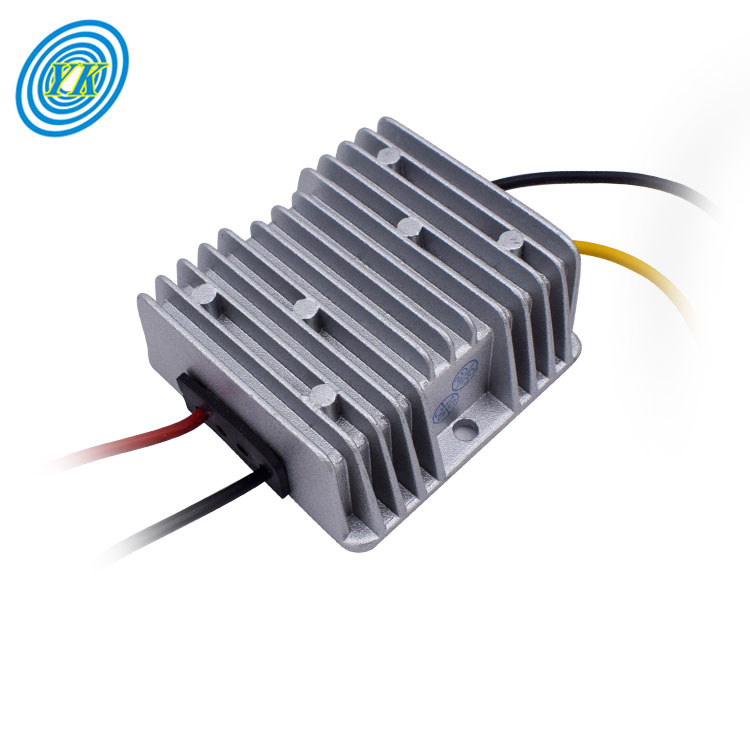
Comprehensive Exploration of Direct Current Conversion Technologies
Click: 748 Date: 01/03/2024 2::22::07 PM
Comprehensive Exploration of Direct Current Conversion Technologies"Understanding DC-DC Converters" is a crucial topic that provides a fundamental understanding of these essential components in power systems.DC-DC converters play a vital role in a wide range of applications, from powering personal computers and office equipment to supplying spacecraft and telecommunication systems. They are designed to convert an unregulated DC voltage (Vg) into a regulated output voltage (V) that varies in magnitude and potentially polarity from Vg.These converters are critical because they ensure high efficiency, which is essential given the difficulty and cost associated with cooling inefficient power converters. Ideally, a DC-DC converter operates at 100% efficiency, although in practice, efficiencies of 70% to 95% are usually achieved.The operation of a DC-DC converter is made possible through the use of switched-mode or chopper circuits. These circuits allow for the control and regulation of the total output voltage through pulse-width modulation (PWM). This technique is also employed in applications involving alternating current, including high-efficiency DC-AC power converters (inverters and power amplifiers), AC-AC power converters, and some AC-DC power converters (low-harmonic rectifiers).There are numerous types of DC-DC converter circuits, each designed to increase or decrease the magnitude of the DC voltage and/or invert its polarity. Some commonly used DC-DC converter circuits include the buck converter, which reduces the DC voltage, and the boost converter, which increases it. Other types include the buck-boost converter, which can both increase and decrease the voltage magnitude, and the Cuk converter, which also inverts the voltage polarity.In conclusion, DC-DC converters are an integral part of modern power systems, playing a key role in the efficient conversion and regulation of DC voltages. Their versatility and efficiency make them indispensable in a wide array of applications."Exploring Switching Regulators": In this section, we delve into the role of switching regulators within the realm of DC-DC conversion. We'll discuss their advantages, disadvantages, and how they have evolved over time.Switching regulators play a crucial role in DC-DC conversion due to their ability to convert input voltage to a desired output voltage with high efficiency. They are particularly useful in power electronics, battery charging, and battery-powered devices. However, like any technology, they come with certain challenges and limitations.One of the key advantages of switching regulators is their high efficiency. Unlike linear regulators that waste power as heat, switching regulators convert electrical energy into heat in the form of a magnetic field, making them more efficient.However, switching regulators also have their drawbacks. One of the main challenges is managing the parasitic elements associated with the transistors and diodes used in these regulators. These elements, known as Equivalent Series Resistance (ESR) and Equivalent Series Inductance (ESL), can affect the performance of the regulator. High ESR can lead to excessive output voltage ripple and regulator loop instability, while high ESL limits the high-frequency effectiveness of the capacitor.The evolution of switching regulators has been marked by continuous improvements in their design and performance. Modern switching regulators incorporate advanced techniques such as pulse width modulation (PWM) control and resonant mode control to reduce ripple and noise, improve efficiency, and enable higher output voltage levels. Furthermore, advances in semiconductor technology have led to the development of smaller, cheaper, and more reliable switching regulators.In this section, we will delve into the recent progress in power semiconductor devices, a critical component in DC-DC converters.Power semiconductor devices are core components in modern electronics, playing a vital role in the conversion and control of electrical power. They have gone through significant evolution in recent years, with new materials and designs improving their performance and efficiency.Silicon-based power devices have been the industry standard for years, but new materials such as gallium nitride (GaN) and silicon carbide (SiC) are emerging as promising alternatives. These materials offer superior electrical properties, including higher breakdown voltage and faster switching speeds, which make them ideal for high-power and high-frequency applications.In addition to new materials, advancements in device architecture and fabrication techniques have also contributed to the progress in power semiconductor devices. For example, the development of vertical device structures has allowed for higher current density and lower on-resistance, leading to more efficient power conversion.Finally, the integration of power semiconductor devices with other electronic components, such as sensors and microcontrollers, is opening up new possibilities for smart and energy-efficient power systems. This integration enables real-time monitoring and control of power conversion processes, improving the overall performance and reliability of DC-DC converters.Please note that these advancements are not without challenges. The adoption of new materials and designs requires significant investment in research and development, and there are technical hurdles to overcome, such as managing heat dissipation and reducing parasitic capacitance. Nonetheless, the potential benefits in terms of improved performance and efficiency make these advancements a key area of focus in the field of power electronics."Power Optimizers: Enhancing Efficiency in DC-DC Conversion""The Basics of Power Optimizers": In this section, we would discuss the fundamental principles behind power optimizers, their role in DC-DC conversion and why they are important in power systems."Efficiency Measurement of Power Optimizers": Here, we would explore how the efficiency of power optimizers is measured. We would look at various methods and standards used to estimate the annual weighted efficiency of these devices ."Impact of Operating Conditions on Power Optimizer Efficiency": This section would delve into the different operating conditions that power optimizers can face and how these conditions affect their efficiency. For example, we would discuss how input power and output voltage conditions influence the efficiency of power optimizers."Case Studies: Power Optimizers in Action": In this part, we would present some case studies that showcase the use of power optimizers in real-world scenarios. This includes instances of partial shading and string lengthening in photovoltaic (PV) systems."The Future of Power Optimizers": Finally, we would look at the future prospects of power optimizers. We would discuss ongoing research, potential improvements, and the impact of advancements in DC-DC converter technologies on the efficiency of power optimizers.The overarching title for this article could be: "Optimizing Power Conversion: An In-depth Look at Power Optimizers in DC-DC Conversion Systems"."Functionality of Boost and Buck Converters": Boost and buck converters are both DC-DC converters, but they serve different purposes. A boost converter steps up the input voltage to a higher level, while a buck converter steps down the input voltage to a lower level. This difference in functionality is crucial in determining which converter to use in a given application."Efficiency and Performance": Both boost and buck converters can achieve high efficiency, but their performance may vary depending on the operating conditions. For instance, buck converters tend to have higher efficiency at high input voltages, while boost converters may perform better at low input voltages."Applications of Boost and Buck Converters": Boost converters are often used in applications where a higher voltage is needed, such as in battery-powered devices or solar power systems. On the other hand, buck converters are commonly used in applications that require lower voltages, such as in power supply units or battery charging circuits."Design Considerations": The design of both boost and buck converters can be complex, with factors such as the choice of components, control strategy, and thermal management playing a crucial role in their performance and reliability."Future Trends": With ongoing advancements in semiconductor technology and power electronics, both boost and buck converters are expected to become more efficient, compact, and reliable in the future.
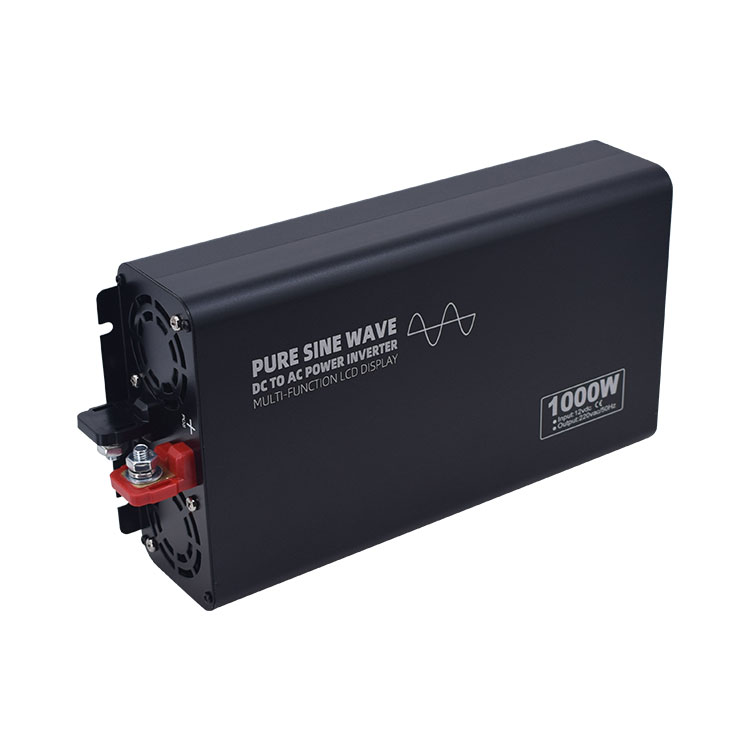
Exploring the Dynamics of Inverter Technology: Types, Applications, and Market Trends
Click: 815 Date: 01/02/2024 2::18::04 PM
Exploring the Dynamics of Inverter Technology: Types, Applications, and Market TrendsUnderstanding Inverter Technology and Its SignificanceInverter technology plays a crucial role in converting direct current (DC) into alternating current (AC), a process vital to numerous applications such as renewable energy systems, electric vehicles, and power electronics. The inverter forms the heart of any power system, and its importance lies in its ability to manipulate the voltage and frequency of the output power, as well as synthesize the output waveforms with different characteristics.The basic design of an inverter involves the use of power semiconductor devices such as transistors or Insulated Gate Bipolar Transistors (IGBTs) which act as switching components in the inverter circuits. These devices enable the rapid switching of the DC power, producing an AC output.Inverter technology has evolved over the years to incorporate advanced designs and control strategies. For instance, modified sine wave inverters use more than two voltages to form a multiple-stepped approximation to a sine wave, reducing voltage and current harmonics compared to a basic inverter. This, however, requires additional switching components, increasing the cost.Another advancement is the use of Pulse Width Modulation (PWM) in inverters, which allows for the regulation or adjustment of the inverter's output voltage, improving the quality of the waveform. PWM control schemes often use variable-frequency motor control inverters as they allow a wide range of output voltage and frequency adjustment.In the context of renewable energy systems, inverters are crucial in converting the DC power produced by solar panels into AC power which can be used in homes or fed into the grid. In such applications, special functions such as maximum power point tracking and anti-islanding protection are integrated into the inverters.In conclusion, understanding inverter technology and its significance is essential in the field of power electronics and renewable energy systems. The technology's ability to convert DC to AC, manipulate output power characteristics, and integrate with renewable energy systems underscores its critical role in modern power systems.Different Types of Inverters and Their ApplicationsInverters are essential devices that convert Direct Current (DC) into Alternating Current (AC). They play a crucial role in various applications such as renewable energy systems, motor controls, and power supply systems. Here are some different types of inverters and their applications:Single Phase Inverters: These inverters are used in low and medium power demand applications. They are characterized by their low cost and ease of design.Three-Phase Inverters: Used in high-power applications, such as High Voltage Direct Current (HVDC) power transmission systems. Their inversion process is more complex than that of single-phase inverters.Square Wave Inverters: These inverters convert DC input into a square wave AC output. While their conversion process is simple, they are not suitable for sensitive electronics due to their high harmonic contents.Sine Wave Inverters: These inverters produce a nearly perfect sine wave output, making them compatible with utility-supplied grid power and all AC electronic devices. However, their design is more complex and costs more per unit power.Grid Tie Inverters: These inverters are designed to inject electricity into the electric power distribution system. They are synchronized with the frequency and voltage level of the grid and contain sophisticated safety features.In terms of applications, inverters are used in Uninterruptible Power Supplies (UPS), AC adjustable speed drives, solar and wind turbine systems, electric vehicles, and even in electroshock weapons. They are also crucial in renewable energy systems, where they convert DC power from solar panels or wind turbines into AC power compatible with other appliances.The Role of Computer and Circuit Technology in InvertersComputer and circuit technologies play pivotal roles in the functionality of inverters. Inverters, which convert direct current (DC) into alternating current (AC), rely heavily on these technologies for their operation.Circuit technology is crucial as it forms the backbone of the inverter. It is responsible for the physical conversion process of DC into AC. This is typically achieved through the use of power semiconductor devices, such as Insulated Gate Bipolar Transistors (IGBTs) or Silicon Carbide (SiC) devices. These components switch on and off rapidly to create a waveform that mimics AC. The design and efficiency of these circuits directly impact the performance and reliability of the inverter.On the other hand, computer technology enhances the functionality of inverters by offering advanced control and monitoring features. Modern inverters often incorporate microcontrollers or digital signal processors to regulate the inverter's operation, optimize its performance, and provide safety features. For instance, these controllers can adjust the switching frequency of the power semiconductors to accommodate different load conditions, thereby improving the inverter's efficiency. They can also monitor the inverter's status and provide early warnings of potential issues, enabling preventive maintenance and reducing downtime.In sum, both computer and circuit technologies are integral to the performance and functionality of inverters. They work together to ensure efficient conversion of power, advanced control capabilities, and reliable operation.Market Trends and Key Players in Inverter TechnologyThe global inverter technology industry has been witnessing significant growth due to various factors such as the increasing adoption of renewable energy sources, advancements in power electronics, and the growing demand for energy-efficient devices. Here are some key trends and players shaping the inverter technology market:Global Market Trends and Growth Factors in Inverter Technology The global inverter market is witnessing significant growth due to the increasing adoption of renewable energy sources, advancements in power electronics, and the growing demand for energy-efficient devices. The rapid decrease in the cost of solar PV installations, especially in technologically advanced nations like the U.S. and Germany, and developing countries globally such as India, is contributing to the growth of the PV inverter market.Regional Insights into Inverter Technology The Asia Pacific region dominated the market with the largest market share in 2023, with China being a major contributor. On the other hand, the U.S. emerged as the largest market in North America in 2023, with trends including an increase in the sizes of central inverters and three-phase string inverters.End-Use Insights: Commercial, Residential, Industrial, and Utilities The utilities segment emerged as the leading segment and accounted for a significant revenue share in 2023. Key players, such as SMA Solar Technology AG and Delta Electronics, Inc., are engaged in manufacturing string and central PV inverters. The residential segment has also witnessed growth due to increased demand for solar renewable energy among consumers.Key Players in Inverter Technology Some key players operating in the inverter market include Siemens Energy, Fimer Group, SMA Solar Technology AG, Delta Electronics, Inc., and SunPower Corporation. These companies have adopted strategies such as new product developments, contracts & agreements, investments & expansions, and mergers & acquisitions to capture a larger share of the inverter market.Future Outlook: Market Size & Trends The global PV inverter market size was estimated at USD 13.09 billion in 2023 and is expected to expand at a compound annual growth rate (CAGR) of 18.3% from 2024 to 2030. The growing awareness regarding environmental issues and the need to reduce carbon emissions are driving the demand for clean energy solutions, which in turn is expected to drive demand for various energy equipment, including PV inverters.The Influence of Policies and Renewable Energy Goals on Inverter TechnologyPolicies and renewable energy goals greatly influence the development and adoption of inverter technology. Here's how:Promotion of Renewable Energy and Decarbonization: Policies encouraging renewable energy and decarbonization, like the New York State’s Climate Leadership and Community Protection Act, drive investments in the electric system, including inverter technology. These policies require a significant percentage of electricity to come from renewable resources, necessitating substantial investments in new, carbon-free resources and additional transmission infrastructure. Inverter technology plays a crucial role in integrating these new resources into the grid.Support for Sustainable Development Goals (SDGs): Inverter technology, particularly solar inverters, aligns with various SDGs presented by the United Nations. They help reduce greenhouse gas emissions and combat climate change (SDG 13), provide access to affordable and clean energy (SDG 7), and foster decent work and economic growth (SDG 8). These goals encourage the advancement and deployment of inverter technology.Influence of Corporate Social Responsibility (CSR): Many businesses incorporate sustainability and renewable energy goals into their CSR strategies. By installing power systems with inverters, they can reduce their carbon footprint and demonstrate a commitment to environmentally responsible methods. This corporate commitment drives the demand and innovation in inverter technology.Technological Advancements and Market Trends: Policies and goals fostering renewable energy adoption lead to technological advancements in inverters. These include increased efficiency, integration with energy storage solutions, and smart grid integration. Market trends driven by policies, such as the decentralization of energy generation and rural electrification, also promote the adoption of inverters .Collaborative Efforts and International Agreements: Public-private partnerships, corporate commitments to sustainability, and international cooperation, like the Paris Agreement, foster the transition to renewable energy. These collaborative efforts create a conducive environment for the deployment of inverter technology
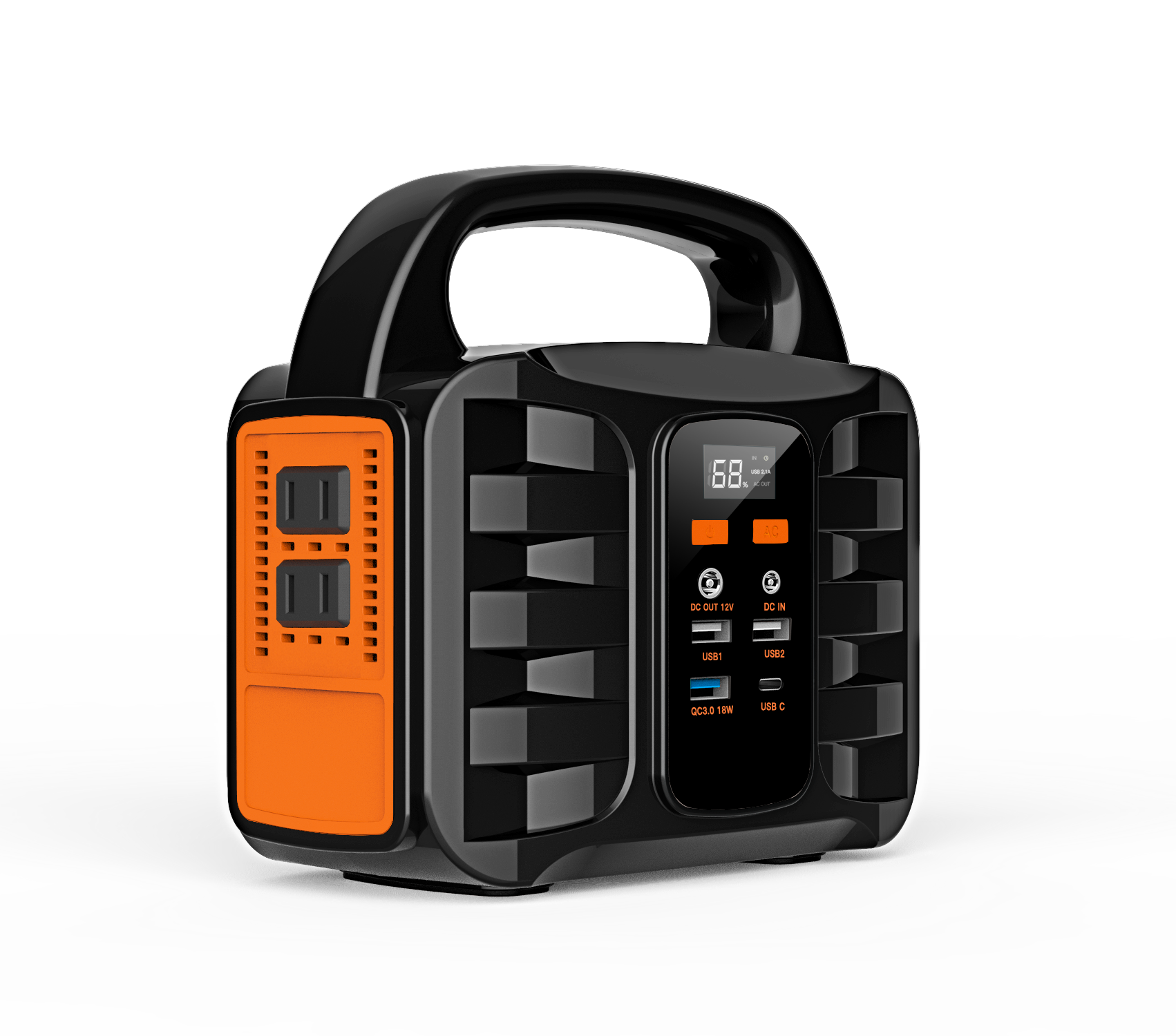
Exploring the Role of YUCOO in the Evolution of Energy Storage Systems
Click: 606 Date: 12/29/2023 5::04::10 PM
Exploring the Role of YUCOO in the Evolution of Energy Storage SystemsEmbracing the Future of Energy Storage: YUCOO's ExpertiseYUCOO has over 20 years of experience in the energy storage industry and specializes in battery energy storage systems, particularly lithium-ion batteries. Their product line ranges from compact home energy storage systems to large-scale grid storage solutions, designed with a focus on efficiency, reliability, and safety. YUCOO's advanced control systems ensure optimal performance and longevity of their products, making them a preferred choice among customers.YUCOO's products are used in a wide range of industries, from telecommunications to medical equipment and aerospace. In telecommunications, for instance, Industrial Battery Chargers are vital for ensuring a stable power supply to communication equipment. They help maintain the operation of communication networks even during power fluctuations.YUCOO's contributions to the energy storage industry are significant and will continue to shape the future of energy storage solutions. As the world continues to embrace sustainable energy practices, companies like YUCOO will play a crucial role in shaping the future of energy.Safety Measures in YUCOO's Energy Storage SystemsDesigning for Safety: YUCOO designs its energy storage systems with safety as a top priority. The systems feature advanced control mechanisms that monitor performance and prevent issues such as overcharging or overheating. This proactive approach to design helps to minimize the risk of hazardous incidents.Advanced Control Systems: The control systems in YUCOO's energy storage products play a vital role in maintaining safety. These systems continuously monitor the performance of the storage devices, detecting any abnormal conditions that could lead to safety risks. In the event of a potential issue, the control systems can shut down the system to prevent accidents.Risk Mitigation: YUCOO is aware of the potential safety hazards associated with energy storage systems, particularly those that use chemical storage solutions like batteries. To mitigate these risks, the company ensures its products are properly managed to avoid issues like fire risks that could stem from improper handling of batteries.Widespread Use Across Industries: YUCOO's energy storage systems are used in a variety of industries, including telecommunications, medical equipment, and aerospace. This widespread use attests to the trust that customers place in the safety and reliability of YUCOO's products.Continuous Improvement and Innovation: YUCOO continually works on improving the safety features of its energy storage systems. This commitment to innovation is part of the company's broader strategy to stay at the forefront of the energy storage industry and continue providing safe, efficient, and reliable solutions.YUCOO's Role in the Growing Market for Energy StorageYUCOO's Expertise in the Energy Storage MarketYUCOO has established itself as a trusted provider of advanced energy storage solutions, specializing in battery energy storage systems, particularly lithium-ion batteries. The company's product line ranges from compact home energy storage systems to large-scale grid storage solutions, all designed with a focus on safety, efficiency, and reliability. Their advanced control systems ensure optimal performance and longevity of their products, making them a preferred choice among customers globally.YUCOO's Response to Market Trends and ChallengesThe energy storage market is expanding rapidly due to increasing demand for renewable energy, falling battery prices, and the growing need for energy storage solutions. However, the market also faces challenges such as the requirement of substantial capital investments and the lack of a robust regulatory framework. YUCOO, recognizing these trends and challenges, continues to invest in research and development to enhance their operational characteristics and introduce new technologies.Safety Measures in YUCOO's Energy Storage SystemsYUCOO is aware of the safety hazards associated with energy storage systems and takes measures to mitigate them. Their systems are designed with safety in mind, featuring advanced control systems that monitor the system's performance and prevent issues like overcharging or overheating. This focus on safety is crucial in an industry where potential risks, if not properly managed, could lead to serious accidents.The Future of YUCOO in the Energy Storage IndustryAs the world continues to embrace sustainable energy practices, there is a growing emphasis on renewable energy sources and a corresponding increase in demand for energy storage systems that can efficiently store and dispatch renewable energy. With its expertise in battery energy storage and its commitment to innovation, YUCOO is well-positioned to contribute significantly to the future development and adoption of energy storage solutions.The Impact of YUCOO's Energy Storage Solutions on the Global Energy LandscapeThe growing market for renewable energy and the shift toward low carbon energy generation are driving advancements in energy storage systems. By enabling the integration of more renewable energy into the grid, energy storage systems like those developed by YUCOO can contribute to sustainability efforts, reducing reliance on fossil fuels. This is a significant contribution, as energy storage systems are crucial for decarbonizing global energy systems and meeting future energy needs.YUCOO's Innovative Approach to Energy Storage SolutionsYUCOO has made significant contributions to the field of energy storage, particularly in the development of battery energy storage systems. They've honed their expertise on lithium-ion batteries, which are known for their high energy density, high power density, and high roundtrip efficiency. These batteries are widely used in various applications, such as electric vehicles and short-duration electricity system storage.One of the key innovations in YUCOO's energy storage solutions is the integration of high-efficiency designs. These designs leverage advanced power conversion technologies and topologies to minimize power losses and maximize energy conversion, resulting in a higher overall efficiency. This focus on efficiency is not only beneficial for the performance of the energy storage system but also contributes to the larger goal of energy conservation and sustainability.In addition to high efficiency, YUCOO's energy storage solutions are designed for reliability. With advanced control systems in place, these solutions ensure optimal performance and longevity. This makes YUCOO's products a preferred choice for both residential and commercial energy storage applications.Looking towards the future, YUCOO, along with other companies in the energy storage industry, will continue to innovate and develop new technologies to meet the growing demand for sustainable and reliable energy storage solutions. This includes the development of low-cost, long-duration storage systems, and the integration of advanced power electronics.Moreover, as the world moves towards decarbonization and the integration of more renewable energy into the grid, energy storage systems will play an increasingly important role. These systems will be needed to store excess power produced by renewable sources and supply it when needed, reducing our reliance on fossil fuels.In conclusion, YUCOO's innovative approach to energy storage solutions is not only shaping the future of the energy storage industry but also contributing significantly to the global push for a more sustainable and clean energy future.The Significance of YUCOO in the Energy Storage Industry1. YUCOO's Expertise and Market PositionWith over two decades of experience in the energy storage industry, YUCOO has established itself as a trusted provider of advanced energy storage solutions. Its specialization in battery energy storage systems, notably lithium-ion batteries, is demonstrated in a wide array of products. These range from compact home energy storage systems to large-scale grid storage solutions, catering to diverse applications.2. Safety Measures in YUCOO's Energy Storage SystemsYUCOO's commitment to safety is evident in the design of its energy storage systems. They are equipped with advanced control systems that monitor the system's performance and prevent issues like overcharging or overheating. This proactive approach to mitigating safety hazards underscores YUCOO's dedication to delivering reliable and safe energy storage solutions.3. YUCOO's Role in the Growing Demand for Renewable EnergyThe increasing global demand for renewable energy and sustainable practices has heightened the need for efficient energy storage solutions. YUCOO's energy storage systems, designed for high efficiency and reliability, facilitate the integration of more renewable energy into the grid. This contributes to reducing reliance on fossil fuels and aids the transition towards a more sustainable energy future.4. Innovative Approach to Energy Storage SolutionsYUCOO's innovative approach to energy storage solutions is exemplified by their incorporation of high-efficiency designs. Utilizing advanced power conversion technologies and topologies, these designs aim to minimize power losses and maximize energy conversion. This focus on innovation underscores YUCOO's commitment to continually improving the efficiency and effectiveness of their energy storage solutions.5. YUCOO's Future Contributions to the Energy Storage IndustryAs the world continues to embrace sustainable energy practices, YUCOO's contributions to the energy storage industry will become increasingly significant. The company's continual investment in research and development, as well as its commitment to delivering high-quality and efficient energy storage solutions, position YUCOO to play a pivotal role in shaping the future of energy storage.
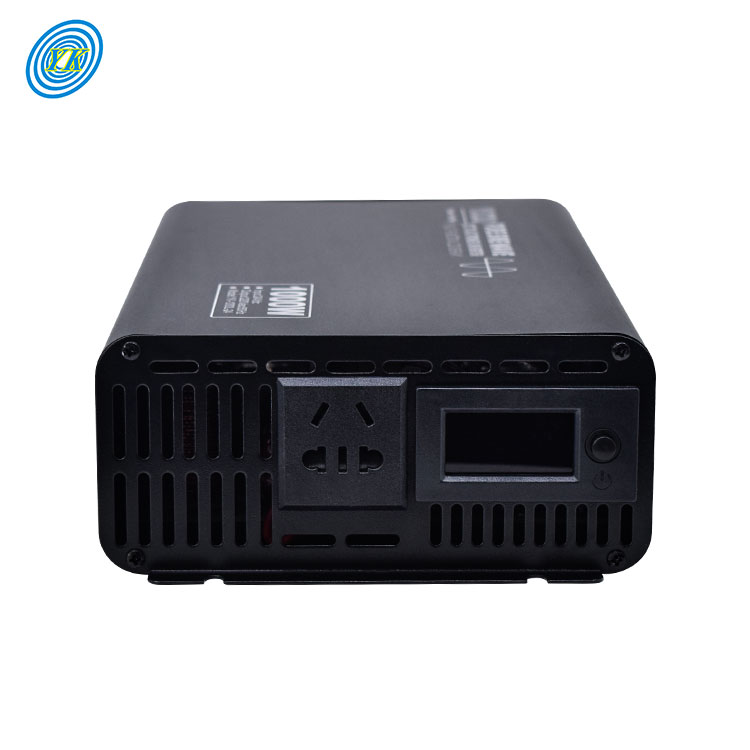
Exploring Yucoo’s Inverters: Innovations, Applications, Installation, Safety, and Market Presence
Click: 734 Date: 12/28/2023 4::23::03 PM
Exploring Yucoo's Inverters: Innovations, Applications, Installation, Safety, and Market PresenceEfficiency and Innovations in Yucoo's Inverter DesignsYucoo has been a leading innovator in power supply for over two decades, creating products that meet the evolving needs of various industries. They've developed high-efficiency inverters that convert DC power into AC power with minimal loss, maximizing energy conversion and promoting energy efficiency.The company uses advanced components, state-of-the-art technology, and innovative design principles to create power inverters that deliver optimal performance, reliability, and efficiency. They offer a wide range of power inverters, designed with specific applications in mind, ensuring they meet the unique power conversion needs of various sectors.Yucoo's inverters also contribute to global sustainability goals by promoting energy efficiency and reducing environmental impact. They use advanced circuit topologies and control strategies, allowing for optimal performance across diverse applications. For instance, their inverters can act as both "source" and "load", enabling energy to flow in both directions, which is particularly useful in applications like electric cars.In addition, Yucoo's inverters are user-friendly and intuitive, with clear control interfaces and detailed user manuals. Many of their inverters feature smart capabilities, allowing for remote monitoring and control.In conclusion, through technological strength, innovative processes, and a focus on sustainability, Yucoo continues to set the bar in the power supply industry with their high-efficiency and innovative inverter designs.Yucoo's Inverters in Various Applications"Yucoo's Inverters: Embracing Technological Advancements for Enhanced Efficiency""Installation, Maintenance, and Safety Measures in Yucoo's Inverters""Customer Satisfaction and Global Recognition of Yucoo's Inverters""Future Trends in the Inverter Market and Yucoo's Position"In the first section, we can discuss the different types of inverters that Yucoo manufactures and their specific applications across various sectors such as solar, wind, industrial, marine and automotive.The second section could focus on how Yucoo leverages advanced circuit topologies and control strategies for optimal performance across diverse applications.The third section could elaborate on how Yucoo ensures easy installation, minimal maintenance requirements, and prioritizes safety in their product design.In the fourth section, we could talk about how Yucoo's commitment to quality and customer service has helped it gain global recognition.Finally, the fifth section could discuss the future trends in the inverter market and how Yucoo is positioned to capitalize on these trends.Installation and User Training for Yucoo's InvertersYucoo's approach to inverter installation and user training is comprehensive and customer-centric. They provide extensive training programs covering operation, maintenance, troubleshooting, and system optimization to help customers maximize the use of their inverters.Installation Guidelines and User Training: Yucoo ensures a smooth installation process by providing detailed manuals with step-by-step instructions. Their inverters are designed for easy installation, with clear labeling and instructions to prevent errors. They also offer technical support to assist customers throughout the installation process.Certification Programs: Yucoo offers certification programs for installers and technicians. These programs involve rigorous training and assessment. Upon successful completion, participants receive a certification that validates their competence in handling Yucoo's products, enhancing their credibility.Ongoing Support and System Optimization: Beyond installation, Yucoo offers ongoing support to ensure their inverters operate efficiently. This includes providing software updates to improve system performance, offering advice on system optimization, and providing prompt assistance for any technical issues.Safety Measures: Safety is a paramount concern when dealing with inverters. Yucoo's inverters are designed with several safety features, including protection against overvoltage, undervoltage, overcurrent, overheating, and short circuits. They also have ground fault protection and isolation measures to protect against electric shocks.Commitment to Customer Satisfaction: Yucoo is committed to supporting their customers through the entire lifecycle of their inverters. From installation to operation and maintenance, they ensure their customers have the necessary resources, training, and support to ensure optimal performance of their invertersStandards and Safety Measures of Yucoo's InvertersYucoo's inverters are manufactured in compliance with a variety of international standards and regulations. These are designed to ensure safety, reliability, and efficiency of inverter products, and they cover various aspects including electrical performance, mechanical design, safety features, and electromagnetic compatibility.Key standards applicable to the inverter industry and adhered to by Yucoo include:IEC 62109: An international safety standard for inverters and converters used in photovoltaic power systems, specifying the minimum requirements for safe design and operation.UL 1741: A standard used widely in the United States and other countries for inverters, converters, controllers, and interconnection system equipment for use with distributed energy resources.IEEE 1547: This standard establishes criteria and requirements for the interconnection of distributed resources with electric power systems.EN 50530: A European standard specifying the procedure for measuring the efficiency of inverters used in grid-connected photovoltaic systems.Yucoo is committed to meeting and exceeding these standards. They have a rigorous quality control process in place that ensures every inverter they produce complies with the relevant standards. Each product undergoes extensive testing and verification before it is released to the market.In addition to adhering to industry standards, Yucoo prioritizes safety in their product design. Their inverters are designed with various safety features, including protection against overvoltage, undervoltage, overcurrent, overheating, and short circuits. They also have ground fault protection and isolation measures to protect against electric shocks.Moreover, Yucoo uses high-quality, flame-retardant materials in their inverter construction to minimize the risk of fire. Their products are also designed for easy and safe installation, with clear labeling and instructions to prevent any installation errors that could pose safety risks.By adhering to industry standards and regulations and prioritizing safety in their product design, Yucoo ensures their inverters are not only efficient and reliable but also safe to use. This commitment to quality and safety has earned them the trust of customers worldwide.Future Trends and Market Presence of Yucoo's InvertersMarket Trajectory and Yucoo's Positioning: The global inverter market is on a positive trajectory, driven by the demand for renewable energy, electrification across various sectors, and advancements in power electronics technology. Within this dynamic market, Yucoo has established a strong position through its focus on quality, innovation, and customer service. Their products are highly efficient, robust, and competitively priced, making them a preferred choice for many customersTechnological Advancements: Yucoo is at the forefront of technological advancements in the inverter industry. Their products leverage cutting-edge power electronics, advanced control algorithms, and sophisticated software to ensure optimal performance and efficiency. The future of inverter technology lies in improving efficiency, reducing size, and integrating smart features, and Yucoo is well-positioned to capitalize on these trendsYucoo's Diverse Range of Inverters: Yucoo offers a diverse range of inverters catering to various needs, including solar inverters, off-grid inverters, and central inverters. Each of these inverters is uniquely crafted to meet the demands of their respective fields, ensuring they function optimally under specific conditionsYucoo's Global Presence and Sales Growth: Yucoo's sales have been growing steadily, thanks to their extensive distribution network spanning across various countries. They have established strong relationships with distributors and suppliers, ensuring their products are readily available to customers worldwideYucoo's Commitment to Safety and Quality: Yucoo uses high-quality, flame-retardant materials in their inverter construction to minimize the risk of fire. Their products are also designed for easy and safe installation, with clear labeling and instructions to prevent any installation errors that could pose safety risksIn conclusion, Yucoo's future in the inverter market looks promising due to their commitment to quality, customer service, and continual innovation. Their diverse product range, technological advancements, and strong market presence position them well to capitalize on the growing trends in the inverter market.
